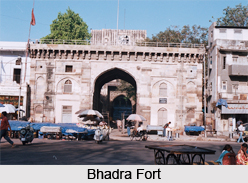 The monuments in Ahmedabad stand tall even to this day to narrate the tale of chivalry, military achievements and architectural splendour. The city of Ahmedabad in Gujarat is situated on the banks of the Sabarmati River. It is also known as the Manchester of West India. It is a large industrial centre and the principal city of Gujarat, Gandhinagar, lies 19 km to the north. The old city of Ahmedabad lies on the left bank of the river, but in recent years it has sprawled across to the right bank, to which it is connected by a series of robust bridges capable of withstanding the seasonal floods. Ahmedabad is also known as the city of Ahmad Shah I who waged incessant wars against his tough Rajput neighbours and as a result of ceaseless punitive expeditions, the Ahmad Shahi dynasty secured a local hegemony which lasted over 150 years. However, inspite of the vicissitudes of fortune, Ahmedabad remains famous for its historic buildings and associations with Gandhi`s social work. It was from here that Mahatma Gandhi commenced his famous march against the Salt Law.
The monuments in Ahmedabad stand tall even to this day to narrate the tale of chivalry, military achievements and architectural splendour. The city of Ahmedabad in Gujarat is situated on the banks of the Sabarmati River. It is also known as the Manchester of West India. It is a large industrial centre and the principal city of Gujarat, Gandhinagar, lies 19 km to the north. The old city of Ahmedabad lies on the left bank of the river, but in recent years it has sprawled across to the right bank, to which it is connected by a series of robust bridges capable of withstanding the seasonal floods. Ahmedabad is also known as the city of Ahmad Shah I who waged incessant wars against his tough Rajput neighbours and as a result of ceaseless punitive expeditions, the Ahmad Shahi dynasty secured a local hegemony which lasted over 150 years. However, inspite of the vicissitudes of fortune, Ahmedabad remains famous for its historic buildings and associations with Gandhi`s social work. It was from here that Mahatma Gandhi commenced his famous march against the Salt Law.
The original settlement in this region was that of the old Hindu town of Asaval, where Ahmad Shah had resided as heir-apparent. He presumably found the place agreeable to him, for in 1411 AD he founded the new city of Ahmedabad, which eventually subsumed Asaval. The foundations of the city and the precise location were vested with deep sanctity and chosen on the advice of his spiritual preceptor. The oldest part of the city, the Bhadra, the royal citadel, was erected in 1411 AD, but the remaining fortifications were erected over a long period of time. According to some historians the remaining parts of the fort was probably completed by 1486 AD. Originally, the city walls comprised 12 gates, 139 towers and over 6,000 battlements, but these are now nearly all demolished, although a few of the old gates remain.
Architecturally, the monuments of Ahmedabad are important as they include some of the most interesting examples of the provincial style which flourished in Gujarat from the mid 15th century onwards. The monuments in Ahmedabad broadly belong to two main eras: the reign of Ahmad Shah I, from the first half of the 15th century, and the period of Mahmud Begada, from the second half of the 15th century and later. The name Begada means `two forts,` commemorating his capture of Champaner and Junagadh. The city has an excellent heritage of vernacular buildings, with fine carved timber houses in Gujarati style.
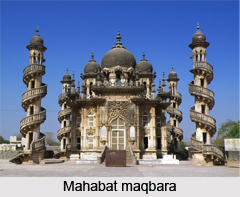 The Jami Masjid or Friday Mosque lies at the centre of the old city. It was completed in 1424 AD and is entered from the north by a flight of steps. The vast courtyard is surrounded by an arcaded cloister. The qibla wall lies to the west. Close to the main arch is a large black slab, which is the inverted base of a buried Jain idol on which the faithful tread. Immediately to the east a white marble crescent marks the spot where the imam leads prayers. The interior is carried on 260 columns divided into fifteen bays, corresponding to three rows of five domes in the roof and five mihrabs. The centre cupola is higher. The central nave rises to three storeys. At each stage of the central gallery are balconies overlooking pillared loggias enclosed by perforated screens. The five mihrabs are all of decorated coloured marble. Originally, there were two lofty minarets, but these were reduced to half their height by an earth-quake in 1819 and the `shaking minarets`, as they were known, were finally demolished by an earth tremor in 1957.
The Jami Masjid or Friday Mosque lies at the centre of the old city. It was completed in 1424 AD and is entered from the north by a flight of steps. The vast courtyard is surrounded by an arcaded cloister. The qibla wall lies to the west. Close to the main arch is a large black slab, which is the inverted base of a buried Jain idol on which the faithful tread. Immediately to the east a white marble crescent marks the spot where the imam leads prayers. The interior is carried on 260 columns divided into fifteen bays, corresponding to three rows of five domes in the roof and five mihrabs. The centre cupola is higher. The central nave rises to three storeys. At each stage of the central gallery are balconies overlooking pillared loggias enclosed by perforated screens. The five mihrabs are all of decorated coloured marble. Originally, there were two lofty minarets, but these were reduced to half their height by an earth-quake in 1819 and the `shaking minarets`, as they were known, were finally demolished by an earth tremor in 1957.
In the enclosure immediately to the cast of the mosque, in the Manek Chowk, is the magnificent Tomb of Ahmad Shah I. He died in 1442, but the tomb was probably commenced in his lifetime. It was restored in 1587. It is a square structure crowned by a dome, with projecting porticos on each side, that to the south providing the main entrance. Enclosed verandas connect the porticos to small square corner chambers capped by small domes. Perforated stone screens allow light to come into the interior. The central chamber, over which rises the main dome, is paved with multi-coloured marble. The centre tomb is that of Ahmad Shah I (1442), that to the left Muhammad Shah, his son (1451), and that to the east, Qutub Shah, his grandson (1458).
Just beyond the tombs, across the street, are the Tombs of the Queens of Ahmad Shah or the Rani-Ka-Hujra. Similar in style to Ahmad Shah`s mausoleum, eight marble tombs stand on a platform within an arcaded and screened outer cloister. The facade has thirteen highly ornamental carved recesses. The centre tomb is probably that of Bibi Mughali, wife of Muhammad Shah II and mother of Sultan Mahmud Begada (1458-1511). Adjacent is another tomb, of black stone once inlaid with mother of pearl, possibly the grave of Murki Bib, sister of Bibi Mughali and first wife of Shah Alam, the saint. The tomb is in poor repair, enclosed by houses and used as a market.
Close to the Astodiya Gate, south-east of the centre of the city, is Rani Sipri`s Mosque, also known as the Masjid-e-Nagira or Jewel of a Mosque on account of its elegant design. Built in 1514 AD, it is a small structure only two bays deep with a row of paired columns to the front. It has been called `one of the most exquisite buildings in the world`. It is strongly Hindu in character, in the style of the early 16th century, with an open facade and crenellated parapet over the cornice. The slender corner minarets are in four sections and the windows arc elaborately embellished with stone tracery.
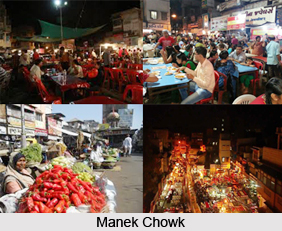 The Rauza or Tomb lies in front of the mosque. It is square in plan with twenty columns enclosing the central chamber. The upper sections have perforated stone screens. The queen`s grave was originally built in marble but is now plastered. Only the inner tomb is raised up beneath the central dome; the lower storey is articulated by carved merlons to the parapet, punctuated by four small corner domes.
The Rauza or Tomb lies in front of the mosque. It is square in plan with twenty columns enclosing the central chamber. The upper sections have perforated stone screens. The queen`s grave was originally built in marble but is now plastered. Only the inner tomb is raised up beneath the central dome; the lower storey is articulated by carved merlons to the parapet, punctuated by four small corner domes.
Other striking monuments in Ahmedabad are the Wells of Dada Hari and Mata Bhavani. Dada Hari (1499) is a peculiar place. A portico provides access to three tiers of platforms linked by spiral staircases that terminate deep underground in an octagonal well, which carries Sanskrit and Arabic inscriptions. The Mosque of Dada Hari, with sinuous traccried windows, is similar to those in Sidi Saiyid`s Mosque. To the north is the Rauza of Dada Hari. A finely carved door leads to a plain interior. The well of Mata Bhavani, reputedly has fifty-two steps leading to the water. This, in turn, is overlooked by pillared galleries. The canopies, niches and friezes exhibit examples of pre-mediaeval Hindu carving.
Besides these there are other mosques like, the Mosque of Dastur Khan (1486), Mosque of Haibat Khan (1425), Mosque of Malik Sha`ban (1452), Mosque of Shah Khub Sayyid (1538), Sakar Khan`s Mosque, Hauz-i-Qutb or Kankariya Lake, Dutch and Armenian Tombs and Mosque of Ibrahim Sayyid (1540). Many of the remaining monuments in Ahmedabad are scattered across the city and its outskirts. Gujarat is famous for its baolis or step-wells and some fine examples can be discovered around Ahmedabad.
In addition to these buildings the Dargah of Shah Alam occupies the centre of the complex and took ten years to be completed. It is designed on a `casket` pattern, with an outer hall enclosed by trellis screens, divided by twenty-eight pillars. The inner sanctum is crowned by a dome which rises over the grave. The main entrance is from the west. Each outer aisle has seven smaller domes to each face, while the main tomb chamber has finely perforated marble jali screens. The inside of the dome is enriched with mother of pearl and semi-precious stones provided by Asaf Khan, brother of Empress Nur Jahan. The brass doors to the tomb show signs of inferior restoration. South of the mosque is a tomb similar to the main mausoleum, where the family of Shah Alam are buried.
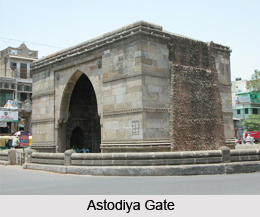 The Shahi Bagh Palace lies close to the railway bridge over the Sabarmati River. This royal garden palace was built in 1622 AD by Shah Jahan, who was then the Viceroy of Ahmedabad. Later, additions were made by Mr Williams, a British civil servant, in 1835, and since 1960 it has been used as the Raj Bhavan of the Governor of Gujarat. An underground passage is alleged to connect Chhata Shahi Bagh with the main house.
The Shahi Bagh Palace lies close to the railway bridge over the Sabarmati River. This royal garden palace was built in 1622 AD by Shah Jahan, who was then the Viceroy of Ahmedabad. Later, additions were made by Mr Williams, a British civil servant, in 1835, and since 1960 it has been used as the Raj Bhavan of the Governor of Gujarat. An underground passage is alleged to connect Chhata Shahi Bagh with the main house.
About 500 metres southward, near the river, is the Mosque of Miyan Khan Chishti (1465), a fine commingling of Hindu and Muslim features built by Malik Maksud Wazir. The screened faqade has three arches, with elaborately carved minarets in the centre. The sanctuary is also in three compartments, that to the centre forming the nave and raised a further storey in height, crowned by three domes. In 1574 AD much of the back wall was replaced when the adjacent area was made into a house.
Achyut Bibi`s Mosque and Tomb, built in 1469 by Imad al Mulk, is a fine amalgamation of Hindu and Muslim elements. The arches supporting the ends of the gallery in the front aisle are an unusual device in Gujarat. Besides these the beautifully decorated mihrab and inner surfaces of the central dome are also noteworthy. The tomb is located to the northeast of the enclosure. It has a central dome, surrounded by eight smaller domes and some good jali screens inside.
Near the railway station of Ahmedabad, there are two other splendid brick minars (early 16th century) similar in style to Sidi Bashir`s.
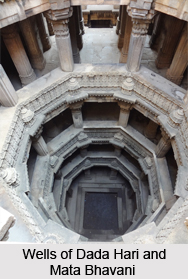 On entering the complex the Mausoleum of Mahmud Begada (1511) lies to the left. It is connected by a fine portico to the tomb of Queen Rajabai, wife of Muzaffar Shah III (1590). Mahmud`s tomb has a balcony window overlooking the adjacent tank and a central dome over the tombs, which are contained on raised platforms.
On entering the complex the Mausoleum of Mahmud Begada (1511) lies to the left. It is connected by a fine portico to the tomb of Queen Rajabai, wife of Muzaffar Shah III (1590). Mahmud`s tomb has a balcony window overlooking the adjacent tank and a central dome over the tombs, which are contained on raised platforms.
Immediately to the right is the Tomb of the Saint. Shaikh Ahmad Khatri Ganj Bakhsh, known as the Maghrabi, was the spiritual guide of Sultan Ahmad I, who retired to Sarkhej and died there at the venerable age of 111 in 1445. The tomb is the largest of its kind in Gujarat, roofed by a vast central dome and several smaller ones. A Persian inscription over the door records the date 1473. The interior is richly ornamented with finely chased brass lattice screens, coloured marble and lavish gilding to the inside of the dome.
A tank was also created by Mahmud Begada and is fed by a channel to the west of the Mosque. It is surrounded by flights of stone steps, and in the southwest corner is the old palace and harem. The supply sluice is richly decorated. To the south of the lake lies the Tomb of Baba Ali Sher, a Muslim saint. Nearby are the remains of the Garden of Victory, laid out by Mirza Khan Khanan (1584) after the defeat of the last of the Ahmedabad sultans, Muzaffar III.
Since the city had been under the reign of the Shahi dynasty for around 150 years, most of the monuments of Ahmedabad reflect an Islamic influence. Whilst the date of construction of most of thee monuments go back to the 15th century, the architecture of the monuments display a blend of Hindu and Islamic styles.




